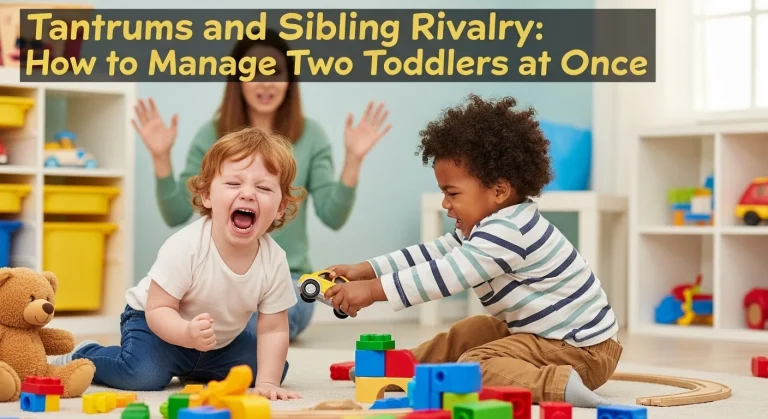Why Some Foods Trigger Toddler Tantrums—and What to Try Instead
If you’ve ever found yourself trapped in a standoff with a toddler over a chicken nugget, you’re not alone. Many moms have witnessed their calm little one transform into a full-blown volcano the moment a certain food hits the highchair tray. But why do some foods cause such dramatic meltdowns—and more importantly, what can you serve instead?
Let’s dive into the science, emotion, and solutions behind food-triggered toddler tantrums and how to reclaim mealtime peace.

The Truth About Toddler Taste Buds (and Why It Matters)
Did you know that toddlers have more taste buds than adults? That’s right—they’re extra sensitive to flavors, textures, and even temperature. What you think is a bland piece of broccoli might taste bitter or overpowering to them.
This sensitivity, combined with toddler development milestones like asserting independence and testing boundaries, sets the perfect stage for a food-related meltdown. Suddenly, it’s not just lunch—it’s a battle of wills.

Food Triggers: The Usual Suspects Behind the Screams
Let’s look at the most common types of foods that often spark tantrums in toddlers—and why:
1. Foods That Look “Weird” or “New”
Toddlers crave familiarity. A slightly darker toast or a different shape of pasta can spark a meltdown simply because it doesn’t “look right.” They may even suspect it’s “yucky” before it hits their tongue.
Mom Tip: Keep shapes, colors, and presentation consistent. Try “deconstructed meals” where they can see each food clearly.

2. Bitter Veggies
Broccoli, spinach, kale—these nutritious greens are also bitter, which toddlers are biologically wired to reject. It’s an ancient survival mechanism to avoid toxic plants, and although it no longer serves a purpose, the dislike remains strong.
What to Try Instead:
Steam and blend greens into fruit smoothies, pasta sauces, or muffins to mask the bitterness with sweetness.

3. Overly Spicy or Strongly Flavored Foods
While some toddlers enjoy flavor, others find strong spices (like garlic, curry, or onions) overwhelming. One whiff and they’re flinging the plate across the room.
Mom Hack: Keep it simple. A dash of salt or a bit of cheese can go a long way in making something more toddler-friendly.

4. Cold Foods When They Expected Warm (or Vice Versa)
Toddlers often expect foods to be a certain temperature. Serving lukewarm oatmeal or a cold slice of pizza can lead to rejection—not because of taste, but because it doesn’t match their mental script.
Quick Fix: Warm or chill to meet their expectations and give a friendly heads-up: “This soup is warm—blow before you sip!”

5. Foods That Are Too Crunchy or Mushy
Texture is everything. A soggy piece of bread or an overly crunchy carrot may throw them off. It’s not just pickiness—it’s sensory sensitivity.
Solution: Find a middle ground. Roasted veggies are less mushy than steamed; slightly cooked carrots are less crunchy than raw.

The Sugar Crash Tantrum (and How It Catches You Off Guard)
Here’s something surprising: even if your toddler loves sugary treats like cookies or fruit juice, those foods can indirectly trigger tantrums. The spike in blood sugar gives them a burst of energy followed by a sudden crash—cue the irritability, frustration, and epic meltdown.
Pro Tip: Pair sugary foods with protein or healthy fat. For example, a banana with peanut butter or a granola bar with yogurt slows the sugar release and keeps moods steadier.

Meal Timing Matters More Than You Think
You might have the perfect meal ready, but if your toddler is already overtired, overstimulated, or hungry past their limit—you’re not getting out of that highchair war unscathed.
This is especially true in busy places like supermarkets. Many meltdowns aren’t about the snack itself—they’re about hunger, fatigue, or overwhelm. For example, tantrums at the grocery store often happen because a toddler is already nearing meltdown mode, and that apple slice didn’t arrive soon enough.

10 Food Swaps That Actually Work (Tried & Tested)
Let’s talk real-life, mom-approved food swaps that help avoid tantrums and still get nutrition in:
| Instead of This | Try This |
|---|---|
| Bitter broccoli | Broccoli tots or cheese-covered steamed broccoli |
| Raw carrots | Lightly steamed carrot sticks or carrot muffins |
| Plain oatmeal | Banana-oat pancakes with a touch of cinnamon |
| Gummy candy | Freeze-dried fruit or date rolls |
| Cold sandwich | Warm grilled cheese triangles |
| Tomato chunks | Tomato paste in pasta or soups |
| Whole apple | Apple slices with cinnamon and peanut butter |
| Soggy zucchini | Roasted zucchini fries with parmesan |
| Strong cheeses | Mild mozzarella cubes |
| Overcooked eggs | Scrambled eggs with cheese or egg muffins |
Empower Your Toddler With Choice (But Not Too Much!)
One of the easiest ways to prevent food tantrums is by giving limited choices.
Instead of saying, “What do you want for lunch?”, say:
➡️ “Would you like pasta or rice today?”
➡️ “Strawberries or bananas for your snack?”
This gives toddlers a sense of control without overwhelming them—and when they feel in control, they’re less likely to flip their plate.

How I Learned This the Hard Way (And How You Can Skip the Drama)
I’ll be honest. My son once screamed for 25 minutes straight because the grapes I gave him were cut. Cut! I thought I was being helpful—he thought I ruined his day. After a lot of trial and error (and a few tantrums of my own), I learned to:
- Ask before slicing
- Let him “help” build his plate
- Stick to routine foods and slowly introduce new ones
The transformation wasn’t overnight, but it worked. Mealtimes are now calmer and dare I say—enjoyable.

Create a Calm Meal Environment
Beyond the food itself, the mealtime setting matters.
✨ Reduce distractions (no screens, no toys)
✨ Sit together as a family when possible
✨ Offer meals at the same time each day
✨ Use calm tones and soft lighting for dinner
Your toddler craves predictability. The more calm and consistent the environment, the less likely they are to use food as a way to express big feelings.

When to Be Concerned (And When Not To)
If your toddler refuses a specific food, that’s normal. If they refuse an entire food group or gag easily, it may be worth speaking to your pediatrician or a feeding therapist. Most pickiness is a phase, but it’s okay to ask for help if it feels too much to handle alone.
Final Thoughts: From Food Fights to Food Fun
Toddler tantrums about food aren’t about you “failing.” They’re about your little one navigating a big world with big feelings—and a very small toolbox for handling them.
The key is to stay calm, get curious, and try again tomorrow. You’re doing better than you think.







